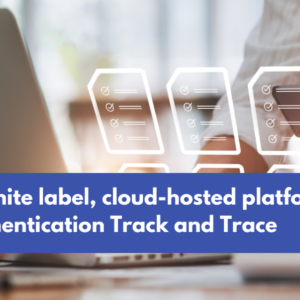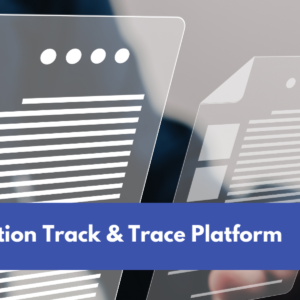This is the second blog post for NanoMatriX’s Pharma Track-and-Trace Series.
The global pharmaceutical industry is prioritizing patient safety and combating counterfeiting through the implementation of track-and-trace solutions. These systems track the movement of medications throughout the supply chain, from manufacturing to the patient.
While this technology offers significant benefits, achieving a truly global track and trace network comes with its own set of hurdles. This article explores the key challenges faced by pharmaceutical companies as they navigate the complexities of global regulations, data management, and technological integration.
What Is Track And Trace For Pharmaceuticals?
Track and trace systems are crucial for ensuring patient safety and the integrity of the pharmaceutical supply chain. These systems track the movement of medications throughout the supply chain, from manufacturing to the patient, by assigning unique identifiers to each product and recording its movement electronically. This allows for verification of a medicine’s authenticity at any point in the supply chain and helps prevent counterfeit drugs from entering the market. Successful implementation relies on collaboration among all stakeholders, including manufacturers, distributors, and dispensaries, to ensure accurate data capture and information sharing.
Importance of Track & Trace in the Pharma Industry
In the pharmaceutical industry, track and trace systems are essential for assuring that medicines are safe, follow rules, and keep patients protected. These systems track drugs from when they’re made until they’re used, making sure they’re real and safe at every stage. They’re vital for stopping fake drugs from getting into the supply chain and harming patients.
Pharmaceutical companies must follow strict rules set by agencies like the FDA in the US and the EMA in Europe. They must carefully record and track medicines to ensure they meet safety, effectiveness, and quality standards. Track and trace systems help by recording how products move through the supply chain, making it easier to follow rules and prepare for checks. This thorough approach not only lowers the risk of fines for breaking the rules but also keeps the supply chain reliable and trustworthy.
Key Challenges in Implementing Global Track & Trace Solutions
1. Diverse Regulatory Requirements
Implementing global track and trace systems is hard because rules differ between countries. Each authority, like the FDA in the US or EMA in Europe, has its own rules on how products should be tracked and traced. Companies need to spend money to follow these rules while keeping their operations running smoothly.
2. Integration with Existing Systems
Pharmaceutical companies face difficulties when they try to add new track and trace systems to their complicated IT setups. The problems include making sure the new systems work well with existing ones, syncing up data correctly, and ensuring they all work smoothly together with systems like ERP, MES, and other software platforms.
3. Data Management and Standardization
Effective track and trace systems depend on accurately capturing, managing, and sharing data throughout the supply chain. This includes data from various sources like production lines, packaging, logistics, and partners. To confirm data accuracy and meet regulatory standards, strong data management frameworks and advanced technologies are necessary.
4. Cost and Resource Allocation
Implementing serialization and traceability systems involves significant expenses such as technology upgrades, software development, and training staff. Small to mid-sized pharmaceutical companies may find it hard to afford these costs. Proper budgeting and resource planning are crucial to handle ongoing maintenance, updates, and compliance checks effectively.
5. Counterfeit and Diversion Risks
Counterfeit drugs and product diversions pose serious threats to patient safety and brand reputation in the pharmaceutical industry. Effective track and trace solutions are essential to combat these risks by providing real-time visibility and authenticating products. Continuous innovation and collaboration across the supply chain are vital for developing scalable measures against counterfeiting.
6. Operational Disruption
Introducing track and trace systems can disrupt existing manufacturing and distribution processes, leading to downtime and logistical issues. Careful planning and execution during system integration and validation phases are essential to minimize disruptions and assure uninterrupted supply chain operations.
7. Global Supply Chain Complexity
The pharmaceutical supply chain involves multiple stakeholders across different regions, including manufacturers, wholesalers, distributors, and pharmacies. Achieving complete visibility and traceability requires aligning processes and systems among all participants. Managing international shipments, regulatory requirements, and geopolitical factors add layers of complexity to implementing global track and trace solutions.
Case Study of Track & Trace Failures
Track and Trace Failure in Western Asia’s Pharmaceutical Supply Chain
Overview:
Western Asia is dealing with a serious health crisis worsened by a lot of fake medicines in its drug supply chain. These counterfeit drugs, which account for over a third of the region’s total pharmaceutical supply, pose significant challenges to healthcare systems already strained by ongoing conflicts, economic hardships, and the aftermath of the COVID-19 pandemic.
Key Issues:
1. Illicit Market Dynamics:
Counterfeit medicines are widespread in Western Asia because there aren’t enough real medicines available. This problem is made worse by wars, people being forced from their homes, and economic problems. People who urgently need medicine often buy it on the black market at high prices. However, these medicines are often useless or even dangerous because the real medicines aren’t available in pharmacies and hospitals.
2. Health Risks and Criminal Practices:
Counterfeit medicines look just like real ones, they’re packaged the same and sometimes even have official serial numbers that were gotten illegally. But these fake drugs often don’t have the right ingredients or contain harmful substances like paint, chalk, or even poison, which can be dangerous to people who take them. According to the World Health Organization (WHO), fake medicines cause tens of thousands of deaths every year worldwide, showing how dangerous they are.
3. Supply Chain Integrity:
Criminal groups take advantage of weaknesses in the system that provides medicines to people. They sometimes steal real medicines or bribe people to get them, then sell these medicines illegally. Smugglers bring in fake medicines that are often labeled with old dates or are contaminated. For example, in Yemen, ten children died after getting injections with fake medicine. These activities don’t just risk lives but also make it harder to keep essential medical supplies safe and reliable.
4. Regional and Global Impact:
Western Asia is an important place for fake medicines to enter the world market. Criminals take advantage of the region’s weak borders, rules, and police forces to move these medicines around. They send fake medicines to Europe and Africa, where they can cause more harm.
Consequences:
- Public Health Impact: Patients unknowingly consume ineffective or harmful medications, exacerbating their health conditions or leading to fatalities.
- Economic Burden: Healthcare systems incur additional costs treating complications arising from counterfeit medicines, further straining already limited resources.
- Regulatory and Governance Challenges: Governments struggle to enforce effective track and trace systems, allowing counterfeit medicines to proliferate and endanger public health.
NanoMatriX: The Perfect Solution
Serialized Labels with Unique Identifiers (UIDs):
NanoMatriX uses barcodes, QR codes, and RFID tags on labels that go on different levels of packaging. This makes sure that each medicine package can be tracked uniquely from the time it’s made until it reaches customers. It helps to know exactly where each product is and if it’s real or not at every step of the delivery process. This system doesn’t just stop fake products but also helps companies follow the rules and gives customers confidence that the medicine they’re getting is safe and real.
MatriX-Mark Inkjet Ink:
NanoMatriX adds special markers into its inkjet ink for strong security, providing powerful ways to prevent counterfeiting and prove products are genuine. This technology helps pharmaceutical companies protect their packaging from being tampered with or copied illegally. It makes sure that their products remain safe and trustworthy as they move through the supply chain.
Vision Inspection Systems and Verification Devices:
NanoMatriX uses advanced tools like high-tech cameras, barcode scanners, RFID readers, and mobile devices to check if the unique IDs (UIDs) on products are readable and genuine immediately. These technologies make sure that data is captured correctly and validated across the entire pharmaceutical supply chain. This helps improve security and makes sure that the company meets all the rules and standards set by regulators.
Aggregation and Data Management Systems:
The aggregation tools help organize different levels of packaging, making it easier to track products through the supply chain. These tools manage Unique Identifiers (UIDs), store data securely, and ensure that all regulatory requirements are met. They also allow for easy sharing and reporting of information across the supply chain, improving overall efficiency and transparency.
Smart Packaging Solutions:
NanoMatriX integrates advanced technologies into the packaging to enhance product protection and consumer trust in a digital marketplace. This approach simplifies inventory management, order fulfillment, and recall processes through aggregated UIDs, reducing errors and improving operational efficiency.
Serialization Management:
NanoMatriX implements precise serialization of pharmaceutical products to assure compliance with diverse serialization and reporting regulations across global markets. This approach facilitates easy integration with existing manufacturing processes, thereby enhancing operational efficiency throughout the supply chain.
Benefits of Using NanoMatriX for Pharma Track & Trace
- Enhanced Security and Authentication: Protects pharmaceutical brands from counterfeit drugs by verifying product authenticity at every stage of the supply chain.
- Regulatory Compliance: Enhances compliance with stringent serialization and reporting requirements, ensuring adherence to global regulatory standards.
- Operational Efficiency: Improves efficiency by integrating easily into existing manufacturing workflows and reducing errors in inventory management and recall processes.
- Consumer Confidence: Builds trust among consumers with app-less authentication and personalized interaction platforms, strengthening brand integrity and market reputation.
Conclusion
Implementing reliable track-and-trace solutions in the pharmaceutical industry is crucial to keeping patients safe, following regulations, and protecting the supply chain. These systems are essential for fighting counterfeit medicines, which are dangerous and harm trust in pharmaceuticals.
Even though there are challenges like different rules from regulators, complicated IT setups, and handling lots of data, technologies like NanoMatriX offer strong tools to enhance security, improve operations, and meet global standards seamlessly.
By being innovative and working together, pharmaceutical companies can reduce risks, safeguard their reputations, and maintain high levels of safety and quality in healthcare.
Read the third blog post for NanoMatriX’s Pharma Track-and-Trace Series here.
About NanoMatriX Technologies Limited
NanoMatriX is a specialist in providing document and brand protection solutions. To solve our customer’s problems, we provide the following product and service categories:
- Brand-/document protection platforms
- Custom Software development
- Cybersecurity services
- Anti-counterfeiting products
- Consulting services
The competitive advantages of NanoMatriX are:
- Two decades of experience helping brand owners and government agencies fight product and document crime worldwide.
- A unique combination of rare-to-find skills in linking physical overt, covert, and forensic security features with secure digital features.
- Proven rigorous application of top cyber security and data privacy protection standards.
- Multi-lingual, multi-cultural, and collaborative corporate culture.
NanoMatriX Technologies Limited is committed to the highest standards of cyber security, data privacy protection, and quality management. Our systems are certified and compliant with leading international standards, including:
- ISO 27001: Ensuring robust Information Security Management Systems (ISMS).
- ISO 27701: Upholding Privacy Information Management Systems (PIMS) for effective data privacy.
- ISO 27017: Implementing ISMS for cloud-hosted systems, ensuring cybersecurity in cloud environments.
- ISO 27018: Adhering to PIMS for cloud-hosted systems, emphasizing privacy in cloud-hosted services.
- ISO 9001: Demonstrating our commitment to Quality Management Systems and delivering high-quality solutions.












Recent Comments